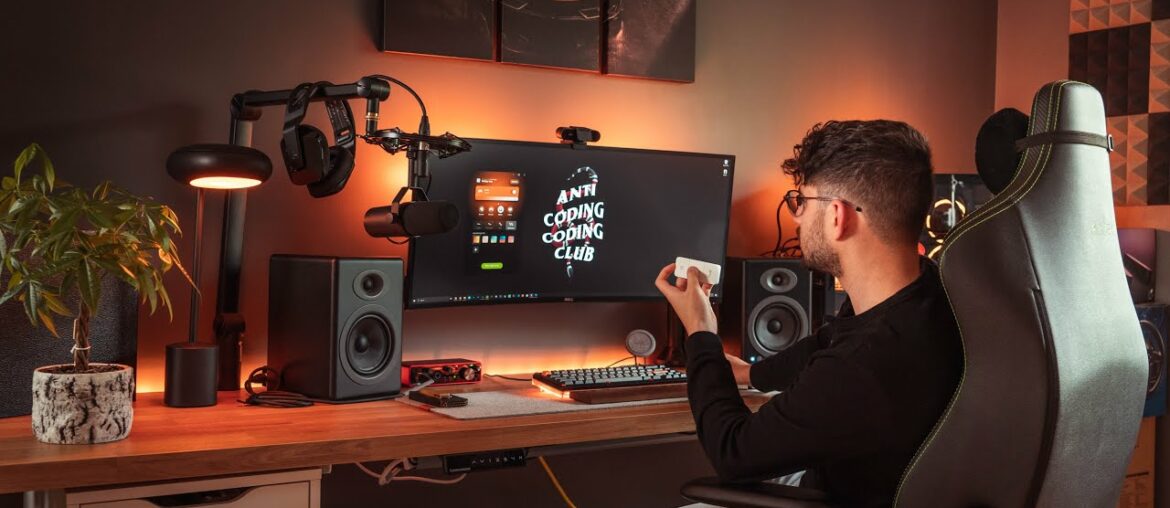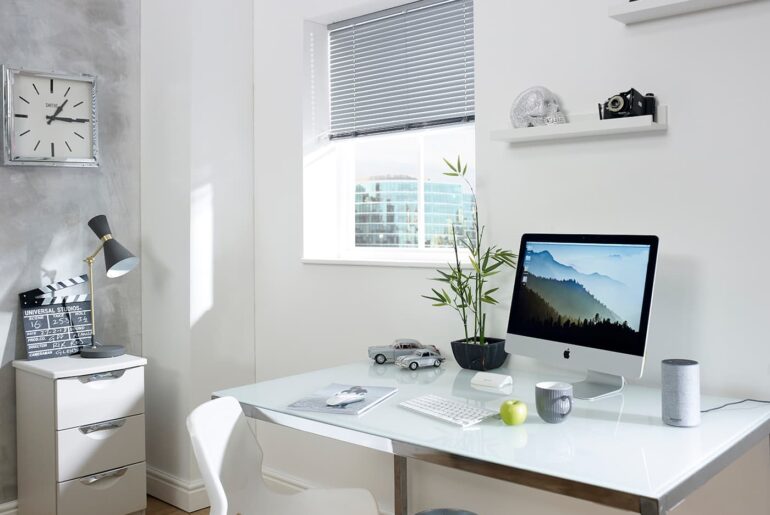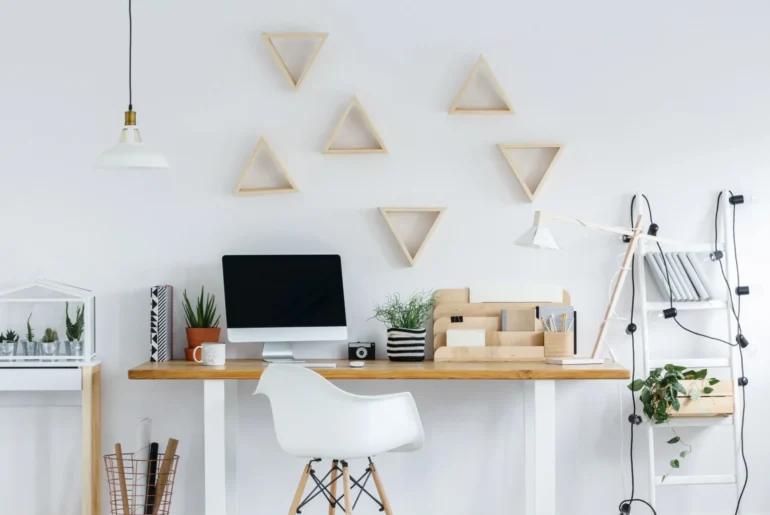Working from home has become increasingly common in recent years, and the global pandemic has further accelerated this trend. As more individuals embrace the convenience and flexibility of remote work, it’s crucial to create a functional and comfortable home office space. One often overlooked aspect of a productive workspace is lighting. In this comprehensive guide, we will explore the importance of home office lighting, understand the basics, and provide practical tips to set up an optimal lighting environment that enhances focus and productivity.
Importance of Home Office Lighting
Lighting plays a significant role in our overall well-being and productivity. The right lighting can boost mood, reduce eye strain, and improve concentration, ultimately leading to enhanced work performance. Conversely, poor lighting can cause fatigue, headaches, and decreased motivation. By optimizing your home office lighting, you can create an environment that promotes productivity and ensures your workday remains enjoyable and fulfilling.
Understanding the Basics
Before diving into the specifics, it’s essential to grasp the fundamental concepts of home office lighting. Two primary lighting sources are available: natural lighting and artificial lighting. Each has its benefits and considerations, and striking the right balance between the two is crucial for an ideal workspace.
Natural Lighting vs. Artificial Lighting
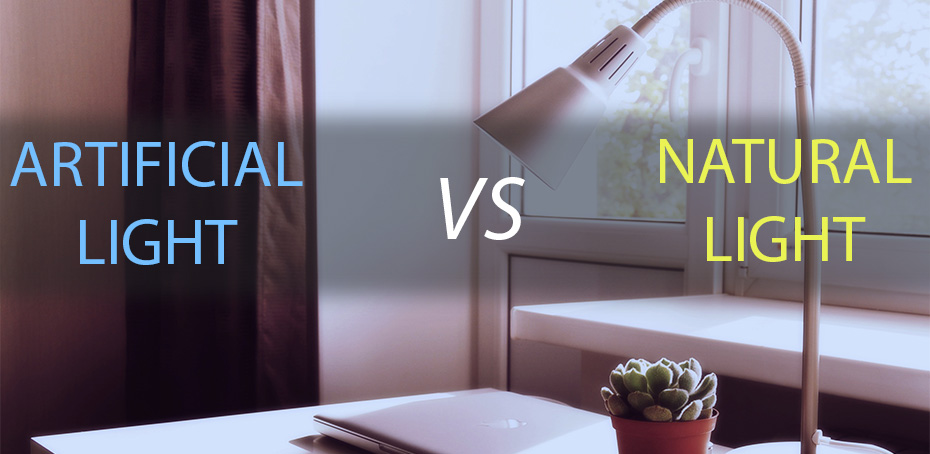
Natural lighting offers numerous advantages, such as providing a sense of openness and connection to the outdoors. It helps regulate our circadian rhythm, enhances mood, and reduces eye strain. When designing your home office, consider positioning your desk near a window to take advantage of natural light. However, be aware of potential glare and the need for additional artificial lighting during cloudy days or after sunset.
Artificial lighting, on the other hand, allows you to have consistent illumination throughout the day and compensates for the lack of natural light. Understanding the different types of light bulbs available and their characteristics is essential for selecting the right lighting fixtures for your home office.
Choosing the Right Light Bulbs
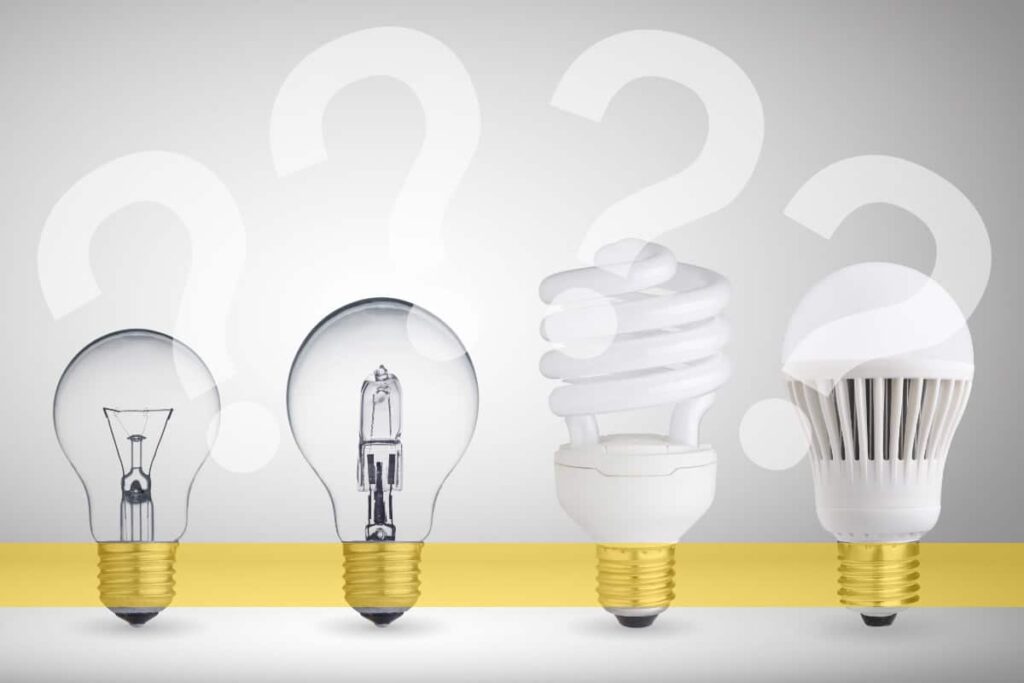
When it comes to artificial lighting, the choice of light bulbs significantly impacts the quality of light in your home office. Here are a few common types:
- Incandescent bulbs: These traditional bulbs emit a warm, yellowish light but are not energy-efficient and have a relatively short lifespan.
- Halogen bulbs: Similar to incandescent bulbs, halogens produce warm light. They are more energy-efficient but still consume a substantial amount of power.
- Compact fluorescent lamps (CFLs): CFLs offer better energy efficiency compared to incandescent and halogen bulbs, but they may take a moment to reach full brightness and can emit a cooler light tone.
- Light-emitting diodes (LEDs): LEDs are highly energy-efficient, have a long lifespan, and provide a range of color temperatures, from warm to cool. They have become the preferred choice for home office lighting due to their versatility and cost-effectiveness.
Consider selecting LED bulbs with a color temperature around 4000K to 5000K for a neutral white light that promotes focus and alertness.
Task Lighting and Ambient Lighting
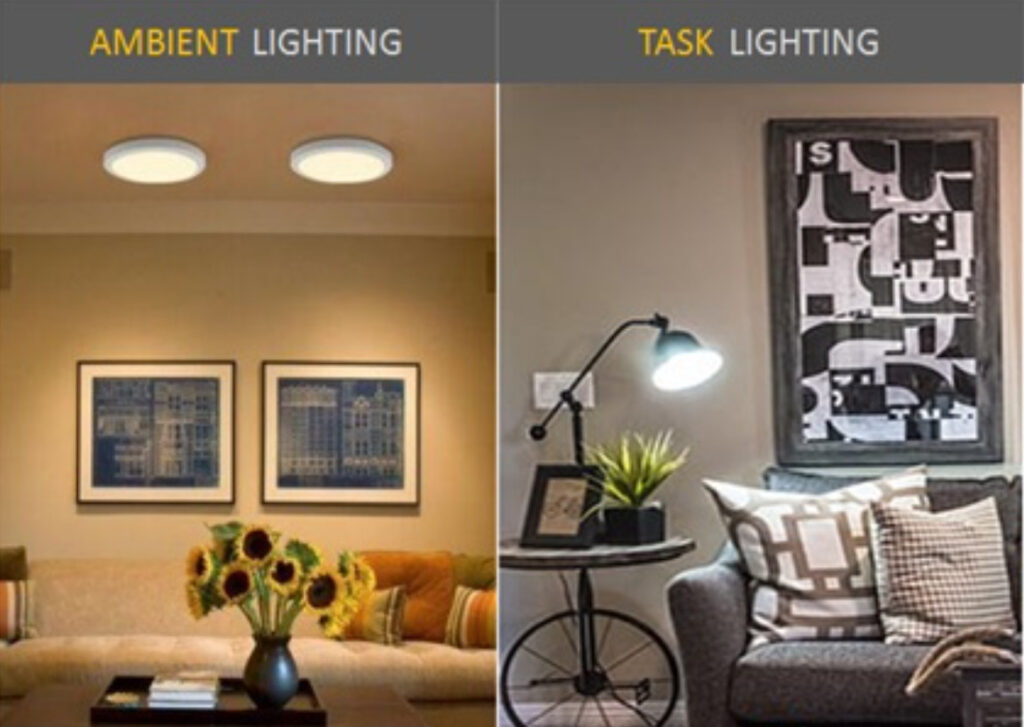
To create an optimal lighting environment in your home office, it’s essential to understand the distinction between task lighting and ambient lighting.
Task lighting involves specific lighting fixtures that provide direct and focused illumination for activities such as reading, writing, or using a computer. Desk lamps, adjustable table lights, or under-cabinet lighting are examples of task lighting sources. Position task lighting to prevent shadows and minimize glare on your work surface.
Ambient lighting refers to general illumination that fills the room. It sets the overall mood and brightness level, providing a comfortable background light. Overhead fixtures, such as ceiling-mounted lights or recessed lighting, can serve as ambient lighting sources. Adjustable dimmers can help customize the brightness to suit your needs throughout the day.
Setting Up Your Home Office Lighting
Now that you understand the basics, let’s explore how to set up your home office lighting for maximum productivity and comfort.
Proper Placement of Lights
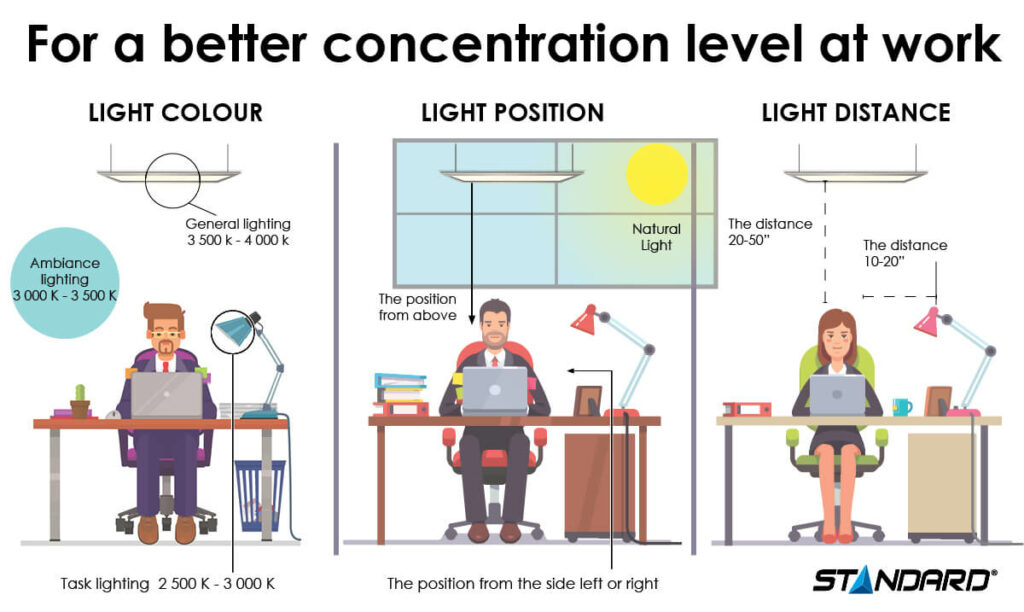
Start by positioning your desk or primary workspace near a window to take advantage of natural light. Ensure that the window is not directly behind or in front of your workstation to avoid glare or harsh shadows.
Next, consider adding task lighting to your desk. Place a desk lamp or an adjustable light source to the side or slightly behind your primary work area. This positioning helps minimize shadows while illuminating your work surface effectively.
For ambient lighting, assess the size and layout of your home office. If the room is small, a single overhead fixture or a combination of recessed lights might suffice. In larger spaces, multiple light sources evenly distributed throughout the room can provide more balanced illumination.
Avoiding Glare and Shadows

Glare and shadows can be major distractions and sources of eye strain. To minimize glare, position your computer screen perpendicular to windows or use blinds or curtains to diffuse direct sunlight. If you’re using a laptop, adjust the screen angle to reduce reflections.
Similarly, ensure that task lighting does not cast shadows on your work surface or computer screen. Consider using a frosted or diffusing shade on your desk lamp to create a softer, more even light distribution.
Using Dimmers and Adjustable Lighting
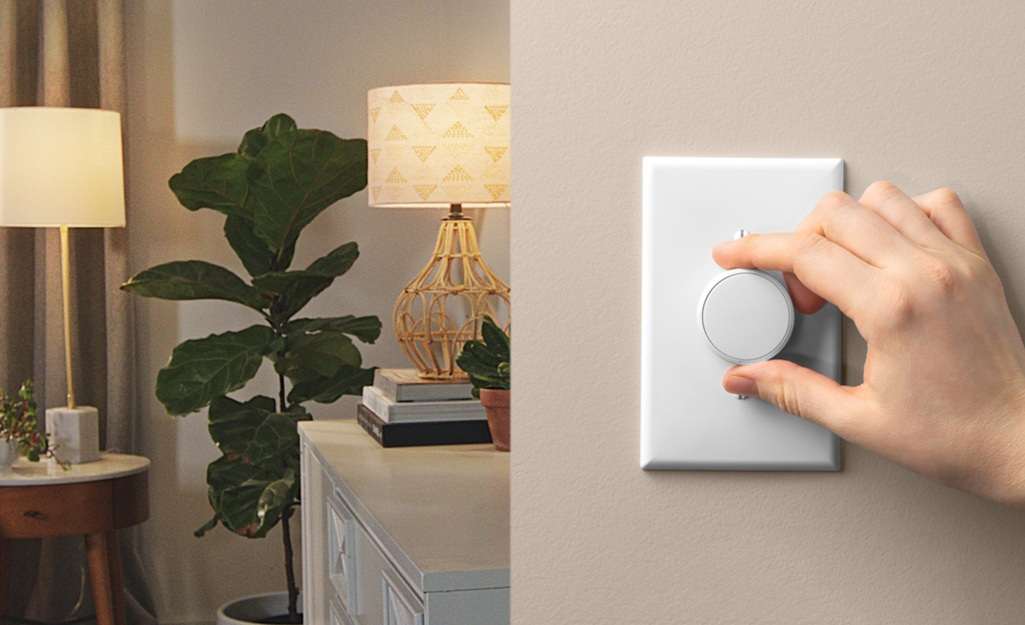
To accommodate different tasks, moods, or times of the day, incorporating dimmers and adjustable lighting is beneficial. Dimmers allow you to control the brightness of your overhead lighting, providing flexibility to adapt to changing lighting needs. Adjustable desk lamps or task lights with dimming features enable you to fine-tune the lighting intensity according to your preference.
Enhancing Productivity and Focus

Home office lighting should optimize your productivity and focus. Here are some additional tips to consider:
- Use bright, cool lighting for tasks that require concentration and attention to detail.
- Incorporate blue-enriched lighting in the morning to enhance alertness and combat drowsiness.
- Use warmer, softer lighting during the evening to promote relaxation and wind down before bed.
- Consider installing smart lighting systems that allow you to adjust lighting settings remotely or according to pre-set schedules.
Managing Eye Strain

Extended screen time and inadequate lighting can strain your eyes. Here’s how you can alleviate eye strain in your home office:
- Ensure your computer screen is positioned at eye level, about an arm’s length away from your face.
- Adjust the screen brightness and contrast to a comfortable level.
- Take regular breaks to rest your eyes and focus on objects at varying distances.
- Consider using blue light filters or glasses that reduce the amount of blue light emitted by your screens.
Creating a Comfortable and Inviting Atmosphere
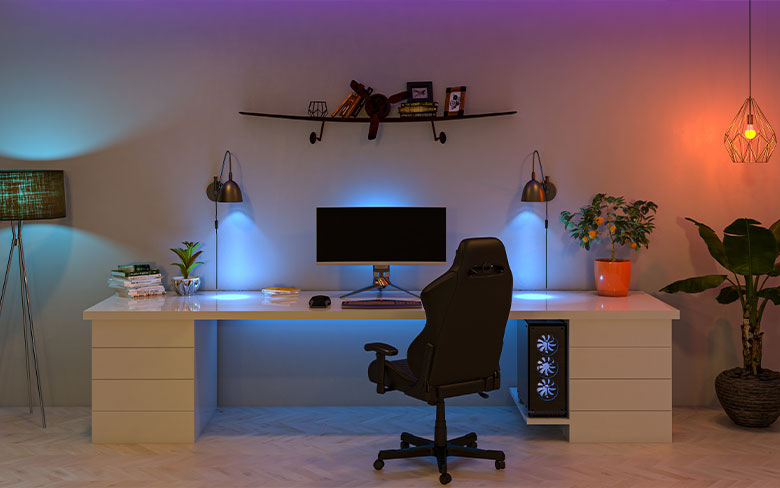
A well-designed home office should not only promote productivity but also create a comfortable and inviting atmosphere. Consider the following tips to enhance the overall ambiance:
- Incorporate decorative lighting elements, such as string lights or accent lamps, to add warmth and personality to your workspace.
- Opt for warm, inviting color temperatures in communal areas or relaxation spaces within your home office.
- Choose lighting fixtures that complement your office decor and reflect your personal style.
Incorporating Personal Style
While functionality is essential, don’t forget to infuse your home office lighting with elements of personal style. Explore lighting fixtures that align with your taste, whether it’s sleek and minimalist, vintage and eclectic, or modern and bold. Remember, a workspace that resonates with your personal aesthetics can contribute to a more enjoyable and inspiring work environment.
FAQs
Q1: What is the best lighting temperature for a home office?
A1: A color temperature of around 4000K to 5000K, providing a neutral white light, is ideal for a home office as it promotes focus and alertness.
Q2: Are LED bulbs the best choice for home office lighting?
A2: Yes, LED bulbs are highly recommended for home office lighting due to their energy efficiency, long lifespan, and versatility in color temperature options.
Q3: How can I reduce eye strain while working in my home office?
A3: Position your computer screen at eye level, take regular breaks, adjust screen brightness and contrast, and consider using blue light filters or glasses.
Q4: Can I incorporate decorative lighting in my home office?
A4: Absolutely! Adding decorative lighting elements, such as string lights or accent lamps, can create a more comfortable and inviting atmosphere in your home office.
Q5: Should I consider dimmers and adjustable lighting for my home office?
A5: Yes, dimmers and adjustable lighting provide flexibility to adapt to different tasks, moods, and lighting needs throughout the day.
Conclusion
Investing time and effort into optimizing your home office lighting is a crucial step in creating a productive and comfortable workspace. By understanding the basics, selecting the right light bulbs, utilizing task and ambient lighting, and considering personal style, you can design a home office that enhances your focus, productivity, and overall well-being. Remember to manage glare, minimize shadows, and incorporate adjustable lighting features to cater to your specific needs. Illuminate your productivity by harnessing the power of well-designed home office lighting.

